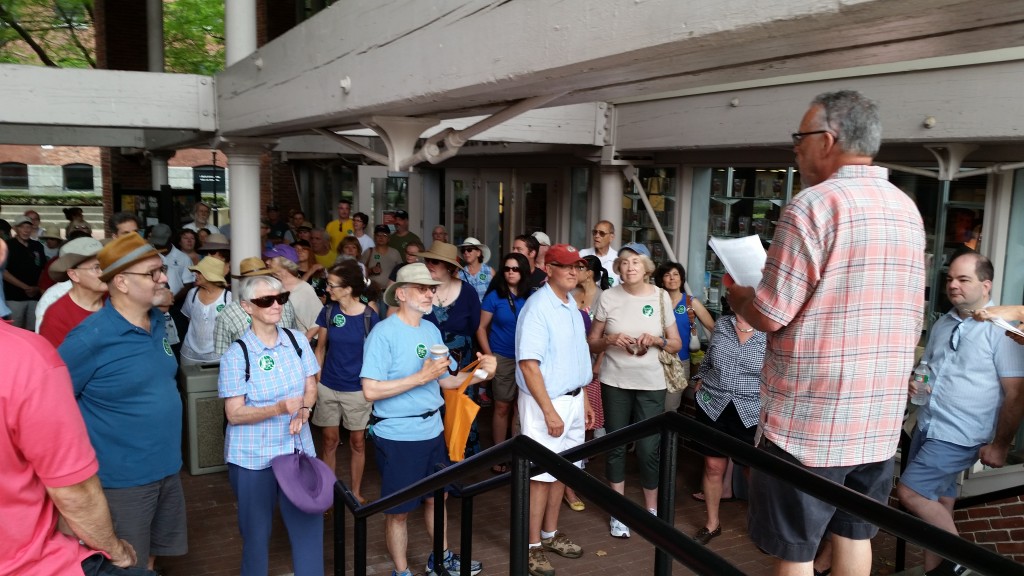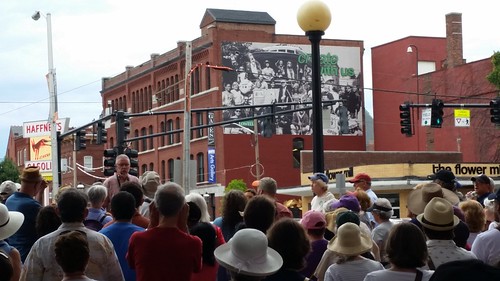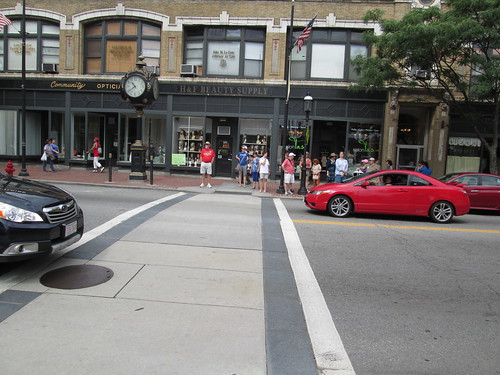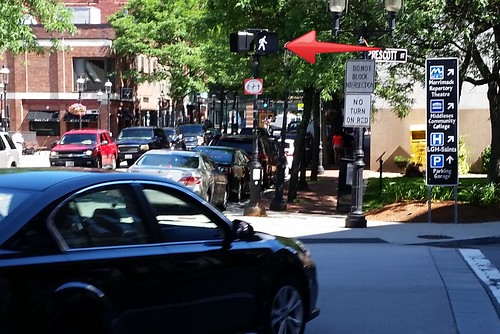Lowell Week in Review: August 2, 2015

We’re all about walking this morning . . .

Bob Forrant & Kim Butler lead 119 people on Abolitionists in Lowell walking tour
Lowell Walks
The Lowell Walks summertime downtown guided walking series resumed yesterday with UMass Lowell History Professor Bob Forrant and one of his students, Kim Butler, leading 119 of us around downtown Lowell and telling us about the Abolitionist movement in Lowell in the decades before the American Civil War. Among the many stops were the Market Mills Courtyard, Central Street at the Pawtucket Canal, the Kirk Street Mill Agent’s House (now the National Park Visitor Center), and St. Anne’s Church.
One of several objectives of Lowell Walks is to bring people into downtown on Saturday mornings for the tours and then to urge them to shop and dine at downtown businesses. Nearly 90 minutes after the completion of the tour yesterday, I still encountered small groups of tour participants emerging from restaurants or carrying shopping bags so the program is having some success in that regard.
Here are the walks that have been held so far this summer with the number of people attending each:
- June 6, 2015 – Preservation Success Stories with Fred Faust – 81 participants
- June 13, 2015 – Lowell Public Art Collection with Paul Marion and Rosemary Noon – 107 participants
- June 20, 2015 – Inside Lowell High School with Brian Martin – 86 participants
- June 27, 2015 – Literary Lowell and the Pollard Memorial Library with Sean Thibodeau – 76 participants
- July 11, 2015 – The Irish and the Acre with Dave McKean – 125 participants
- July 18, 2015 – Green Lowell with Jay Mason – 43 participants
- August 1, 2015 – Abolitionists in Lowell with Bob Forrant – 119 participants
That’s a total of 637 tour participants thus far for an average of 91 per tour. That’s a lot of people coming into downtown Lowell on Saturday mornings. Here are the remaining tours:
- August 8, 2015 – Hamilton Canal District with City of Lowell Department of Planning and Development
- August 15, 2015 – Natural Lowell with Jane Calvin
- August 22, 2015 – Lowell Artists, Past and Present with Jim Dyment
- August 29, 2015 – Lowell Monuments with Richard Howe
- September 5, 2015 – Trains and Trolleys in Lowell with Chris Hayes
- September 12, 2015 – Renewing the Acre with Dave Ouellette
Besides those on the Lowell Walks tour yesterday, there seemed to be quite a few others roaming around downtown yesterday. I’m guessing that last evening’s Gordon Lightfoot performance at Boarding House Park as part of the Lowell Summer Music Series was the draw. The Music Series’ model encourages attendees to show up early – like 12 hours early – and place a lawn chair in Boarding House Park to save a seat. While those who live in Lowell just go back home, I suspect that some coming from far away just stay here for the day.
City Council Meeting – Walkability Focus (or lack thereof)
There were a couple of discussions that touched on walking during last Tuesday’s City Council meeting that I found perplexing. One was the “presentation” by the State Department of Transportation official on the changes to be made to the intersection of Bridge Street and the VFW Highway. In the gentleman’s defense, he seemed to have gotten late notice of his assignment to be at the council meeting, at least that’s how he explained his inability to explain the project or to answer any questions about it. From what he did say, it sounded as if the job is simply to repave the intersection as it exists now with a slight modification to the adjacent Lakeview Ave/VFW intersection but otherwise with no meaningful changes.
Councilor Kennedy asked about the operation of the pedestrian crossing lights and the DOT official seemed to say that whenever a pedestrian pushes the crossing button, all traffic lights will turn red, freezing vehicular traffic, and allowing walkers to cross. That seemed to dismay Councilor Kennedy, mostly because the increased waiting time for those in vehicles and because the proposed change will do nothing to alleviate the major traffic backups that now plague that intersection. I concur with Councilor Kennedy, not because of the inconvenience to drivers but because I am of the belief that the “all red lights to let pedestrians cross” doesn’t work for walkers, either.
The Cambridge, Massachusetts Department of Traffic, Parking and Transportation has a great explanation of its street-crossing policy on its website.
This is very important stuff, so I’ve reproduced almost the entire thing below. Please continue reading, because it gives an excellent, concise explanation of the considerations that should be followed in setting a street crossing policy:
Concurrent Pedestrian Signals
This page explains the Traffic, Parking and Tranportation (TP&T) Department policy on operation of pedestrian traffic signals. It explains the two types of operations and why concurrent operations is preferred in Cambridge
Types of Pedestrian Operation
The WALK and DON’T WALK signs, also called pedestrian (or ped) signals indicate the best time during the signal cycle for pedestrians to cross the street. We can choose one of two methods of operation, as explained below.
Exclusive Operation
Pedestrians have exclusive use of the intersection. All WALK signals illuminate at the same time, while all the vehicle signals are red. (Some call this a “Barnes Dance,” named for the legendary New York City traffic engineer Henry Barnes.) The obvious advantage of this operation is that pedestrians do not have to share the road with turning vehicles (provided that none are turning right on red, legally or illegally). Second, fast walkers can cross the intersection diagonally.
But there are some less obvious but important disadvantages. First, in an urban environment with congested intersections, we can spare only the minimum time (as defined by engineering standard) of seven seconds for the WALK interval because the lines of vehicle traffic continue to grow while all the intersection lights are red. In addition to providing a short window for people to start crossing the street, pedestrians must wait for an intolerable period before finally getting their turn – sometimes a minute and a half or more. Many pedestrians are not willing to wait nearly this long. Traffic engineers usually install buttons to push to activate the WALK signal, which adds more wait time.
Concurrent Operation
Vehicles are permitted to turn right and/or left across the crosswalk while a WALK sign is showing. Drivers must yield the right of way to anyone in the crosswalk, just like they do when turning onto a side street where no traffic signal exists. When vehicles and pedestrians can use the intersection at the same time, we can leave the WALK sign on for much longer. Further, pedestrians wait far less time for the WALK sign to come on. Finally, the WALK sign comes on every cycle without needing to press a button.
A Head Start
Recognizing that turning vehicles can put pedestrians at a disadvantage, Cambridge intersections give pedestrians a head start. Engineers call this a Leading Pedestrian Interval, or LPI. Our LPIs are a minimum or 3 seconds and are longer for larger intersections. While this may not sound like much, it is plenty of time for pedestrians to walk several feet into the crosswalk and establish control of the space. By the time the first turning car reacts to the green light, several pedestrians are well within view, giving the driver adequate time to react and stop before finishing the turn.
Safety in Numbers
Multiple studies along with our own experience in Cambridge shows that pedestrians are safer in larger groups. Visibility is the most important element of roadway safety in an urban environment and a crowd is easily seen by drivers. In other words, it is best when all pedestrians use the crosswalk at the same time.
Voting With Their Feet
TP&T staff learned long ago that Cambridge pedestrians are clearly comfortable crossing concurrently with the green light no matter what the pedestrian signal indicated. So when traffic signals were set to run exclusive, most pedestrians crossed with the green light. Others pushed the button and were not willing to wait for the WALK sign and crossed with the green light anyway. A few waited for the WALK sign. As a result, pedestrians used the same crosswalk at different times. Drivers did not know when to expect to see pedestrians in the crosswalk.
Since pedestrians want to cross with the green light, we designed our traffic signals to accommodate them. With concurrent pedestrian operation, drivers know when to expect pedestrians to be in the crosswalk. And since they are all crossing at about the same time, the large group of pedestrians will be highly visible.
Department Policy
In 1997 TP&T made concurrent pedestrian operation with LPI official Department policy. Since then crashes involving pedestrians have declined.
As noted in the Policy, there are some exceptions to this policy. Most notably, at T intersections, where all vehicles are turning either left or right onto the main street, concurrent operation is not feasible. Second, where the number of turning vehicles is very high, we may choose to use exclusive operation.
The above Cambridge policy lays out the reality of pedestrians and street-crossings in a rational manner. That’s something that was lacking in Lowell Tuesday night during the discussion of three motions filed by three different councilors that touched on the topic of jaywalking. Now I get just as aggravated as the next driver when someone wanders aimlessly out into the road in front of me when I’m behind the wheel. I don’t justifying that behavior, but to think that the offenders who cross streets that way are going to curb their behavior because of the threat of a fine – be it $1 or $20 or $200 – is ludicrous.

Why no council motions about drivers who fail to yield to pedestrians in crosswalks?
I’d prefer the council spend its time discussing ways to make downtown streets safer and more convenient for all walkers. As Jeff Speck said expressly and as the Cambridge policy says obliquely, walkers want to walk and if you expect them to stop walking and wait for several minutes for a crossing light to go on, they will not wait for the crossing light. As someone who walks a lot in downtown, that observation has the ring of truth to it. Those who suggest otherwise ought to get out of their cars and use their feet for transportation more often.
If they did that, they would understand that much of downtown Lowell is inhospitable to walkers. Part of that is a function of poor design (Dutton Street and the Lord Overpass) and part of it is a driving culture that is antagonistic towards pedestrians. The driver behavior problem should be addressed through increased enforcement of those who violate existing laws and ordinances intended to make the streets safe for walkers. Between drivers fiddling with their cell phones and those who are oblivious to rights of pedestrians to safely cross streets, walking is often a life-threatening activity. More often than not when I’m crossing a downtown intersection when the pedestrian light signals me to do so, I have to dodge either cars turning in front of me or insults hurled by those drivers who have to stop to let me pass.

Drivers in Lowell don’t believe that a pedestrian with a white crossing light takes priority over a car with a green light
As for the problem of design, that might be improved by those who want Lowell made safer for walkers pressing elected officials and city planners to adopt more walk-friendly designs in future projects. An opportunity to do just that will occur at the City Council meeting on August 11, 2015. That night at 7 pm, the Council will hold a public hearing on a Complete Streets Policy.
Here is the first paragraph of a pretty good Wikipedia entry on Complete Streets:
Complete Streets is a transportation policy and design approach that requires streets to be planned, designed, operated, and maintained to enable safe, convenient and comfortable travel and access for users of all ages and abilities regardless of their mode of transportation. Complete Streets allow for safe travel by those walking, bicycling, driving automobiles, riding public transportation, or delivering goods.
Sometime after the August 11, 2015 public hearing, the Council will vote to adopt the city’s own Complete Streets Policy. I think it’s critically important that everyone who wants Lowell to become more walker-friendly show up for the public hearing. I don’t know what it was the prompted three councilors to file motions last week to make life easier for drivers but I would guess it’s because a certain number of drivers lodged complaints about jaywalkers with the councilors.
No councilors are filing motions to make the streets and sidewalks safer and more convenient for walkers and bikers because too few walkers and bikers are making their wishes known to councilors. This August 11 public hearing should not be just about Complete Streets, it should serve as the kickoff of a grass roots walkability campaign that lasts throughout the summer and fall – right up through the city election, in fact. A large crowd sends a strong message so please make every effort to be at the council meeting on August 11.
Thanks Dick. The walks have been fabulous. Look forward to discussing expansion in scope and dates.
The walks are working, not only for the walkers, but also the downtown businesses – great idea!
I noticed much improved pedestrian walk signals installed in the downtown, at least along Merrimack street. Hopefully, those are, or will be, extended throughout the downtown.
Where there are no lights, pedestrian crossing becomes more tenuous. Maybe the city has to install curb bump-outs in those locations so that pedestrians can clearly be seen as waiting to use the crosswalks, as well as lessening the distance for crossing.
The bridge street intersection cannot really benefit from all-red, as the great majority of pedestrian crossing are along the 2 sides of Bridge street, not across Bridge street. However, to allow safe crossing of the VFW it is probably necessary to have not only red for the VFW traffic, but also red arrows to prevent the left turns into the pedestrians, as the left-turning traffic is at a higher speed than the right-turning traffic.